Modifications in the Topological Structure of EEG Functional Connectivity Networks during Listening Tonal and Atonal Concert Music in Musicians and Non-Musicians
Abstract
:1. Introduction
2. Materials and Methods
2.1. Groups and Sound Stimulus
2.1.1. Participants
2.1.2. Sound Stimuli
2.1.3. Acoustic Properties of Sound Stimuli
2.2. Acquisition of EEG Signals
2.3. Analysis
- 1.
- Preprocessing
- 2.
- Measuring EEG functional connectivity y (FC)
- 3.
- Graph-based analysis
- 4.
- Topological measures of EEG-FC networks
- 5.
- Statistical analysis of stimuli acoustic features
- 6.
- Network-based statistic (NBS)
- 7.
- Permutation test for comparisons between the nodal indices of two graphs
- 8.
- Statistical analysis of graph/network indices
3. Results
3.1. Acoustic Features of Sound Stimulus
3.2. Results of the Network Based Statistic (NBS)
3.2.1. Between-Group Comparisons in Each Audition Separately
3.2.2. Pairwise Comparisons between Auditions in Each FB and in Each Group Separately
3.3. Results from Graph Metric
3.3.1. Global Centrality Measures of EEG Graph
3.3.2. Efficiency Indices of the Internode Communication of the EEG Graph
3.3.3. Results of the Graph Metric at the Node Level Topographic Maps
3.3.4. Results from Between-Group Differences Comparisons during Auditions
4. Discussion
4.1. Common Features to Musicians and Non-Musicians during Auditions
4.2. Differences between Auditions in Each Group Separately
4.3. Between-Group Differences during Auditions
5. Conclusions
Supplementary Materials
Author Contributions
Funding
Institutional Review Board Statement
Informed Consent Statement
Data Availability Statement
Acknowledgments
Conflicts of Interest
References
- Nozaradan, S.; Peretz, I.; Missal, M.; Mouraux, A. Tagging the Neuronal Entrainment to Beat and Meter. J. Neurosci. 2011, 31, 10234–10240. [Google Scholar] [CrossRef] [PubMed]
- Nozaradan, S. Exploring how musical rhythm entrains brain activity with electroencephalogram frequency-tagging. Philos. Trans. R. Soc. Lond. Ser. B Biol. Sci. 2014, 369. [Google Scholar] [CrossRef] [PubMed] [Green Version]
- Collins, T.; Tillmann, B.; Barrett, F.S.; Delbé, C.; Janata, P. A combined model of sensory and cognitive representations underlying tonal expectations in music: From audio signals to behavior. Psychol. Rev. 2014, 121, 33–65. [Google Scholar] [CrossRef] [PubMed]
- Krumhansl, C.L. Cognitive Foundations of Musical Pitch; Oxford University Press: Oxford, UK, 2010. [Google Scholar] [CrossRef]
- Koelsch, S. Brain correlates of music-evoked emotions. Nat. Rev. Neurosci. 2014, 15, 170–180. [Google Scholar] [CrossRef] [PubMed]
- Meltzer, B.; Reichenbach, C.S.; Braiman, C.; Schiff, N.D.; Hudspeth, A.J.; Reichenbach, T. The steady-state response of the cerebral cortex to the beat of music reflects both the comprehension of music and attention. Front. Hum. Neurosci. 2015, 9, 436. [Google Scholar] [CrossRef] [PubMed] [Green Version]
- Trost, W.J.; Labbé, C.; Grandjean, D. Rhythmic entrainment as a musical affect induction mechanism. Neuropsychologia 2017, 96, 96–110, Erratum in 2020, 136, 107235. [Google Scholar] [CrossRef] [PubMed] [Green Version]
- Rohrmeier, M.A.; Koelsch, S. Predictive information processing in music cognition. A critical review. Int. J. Psychophysiol. 2012, 83, 164–175. [Google Scholar] [CrossRef] [PubMed]
- Pearce, M.; Wiggins, G.A. Auditory Expectation: The Information Dynamics of Music Perception and Cognition. Top. Cogn. Sci. 2012, 4, 625–652. [Google Scholar] [CrossRef] [PubMed]
- Gebauer, L.; Kringelbach, M.L.; Vuust, P. Ever-changing cycles of musical pleasure: The role of dopamine and anticipation. Psychomusicol. Music Mind Brain 2012, 2, 152–167. [Google Scholar] [CrossRef] [Green Version]
- Salimpoor, V.N.; Zald, D.H.; Zatorre, R.J.; Dagher, A.; McIntosh, A.R. Predictions and the brain: How musical sounds become rewarding. Trends Cogn. Sci. 2015, 19, 86–91. [Google Scholar] [CrossRef]
- Bonin, T.; Smilek, D. Inharmonic music elicits more negative affect and interferes more with a concurrent cognitive task than does harmonic music. Atten. Percept. Psychophys. 2016, 78, 946–959. [Google Scholar] [CrossRef] [PubMed] [Green Version]
- Bodner, E.; Gilboa, A.; Amir, D.D. The unexpected side-effects of dissonance. Psychol. Music 2007, 35, 286–305. [Google Scholar] [CrossRef]
- Masataka, N.; Perlovsky, L. The efficacy of musical emotions provoked by Mozart’s music for the reconciliation of cognitive dissonance. Sci. Rep. 2012, 2, 694. [Google Scholar] [CrossRef] [PubMed] [Green Version]
- Pereira, C.S.; Teixeira, J.; Figueiredo, P.; Xavier, J.; Castro, S.L.; Brattico, E. Music and Emotions in the Brain: Familiarity Matters. PLoS ONE 2011, 6, e27241. [Google Scholar] [CrossRef] [PubMed]
- Krumhansl, C.L.; Cuddy, L.L. A theory of tonal hierarchies in music. In Handbook of Auditory Research; Jones, M.R., Ed.; Springer: New York, NY, USA, 2010. [Google Scholar]
- Aubé, W.; Peretz, I.; Armony, J.L. The effects of emotion on memory for music and vocalisations. Memory 2013, 21, 981–990. [Google Scholar] [CrossRef]
- Imberty, M. L’acquisition des Structures Tonales Chez L’enfant; Klincksieck: Paris, France, 1969. [Google Scholar]
- Koelsch, S. Towards a neural basis of music-evoked emotions. Trends Cogn. Sci. 2010, 14, 131–137. [Google Scholar] [CrossRef]
- Zatorre, R.J. Musical pleasure and reward: Mechanisms and dysfunction. Ann. N. Y. Acad. Sci. 2015, 1337, 202–211. [Google Scholar] [CrossRef]
- Koelsch, S. Brain and Music; Wiley Blackwell: Hoboken, NJ, USA, 2012. [Google Scholar]
- Flores-Gutiérrez, E.; Díaz, J.L.; Barrios, F.; Favila-Humara, R.; Guevara, M.; Río-Portilla, Y.; Corsi-Cabrera, M. Metabolic and electric brain patterns during pleasant and unpleasant emotions induced by music masterpieces. Int. J. Psychophysiol. Off. J. Int. Organ. Psychophysiol. 2007, 65, 69–84. [Google Scholar] [CrossRef]
- Bhattacharya, J.; Petsche, H.; Pereda, E. Long-range synchrony in the gamma band: Role in music perception. J. Neurosci. 2001, 21, 6329–6337. [Google Scholar] [CrossRef] [Green Version]
- Patel, A.D.; Balaban, E. Temporal patterns of human cortical activity reflect tone sequence structure. Nature 2000, 404, 80–84. [Google Scholar] [CrossRef]
- Bhattacharya, J.; Petsche, H. Universality in the brain while listening to music. Proc. R. Soc. Lond. 2001, 42, 287–301. [Google Scholar] [CrossRef] [PubMed] [Green Version]
- Baumgartner, T.; Esslen, M.; Jancke, L. From emotion perception to emotion experience: Emotions evoked by pictures and classical music. Int. J. Psychophysiol. 2006, 60, 34–43. [Google Scholar] [CrossRef] [PubMed]
- Aftanas, L.; Reva, N.; Savotina, L.; Makhnev, V. Neurophysiological correlates of induced discrete emotions in humans: An individually oriented analysis. Neurosci. Behav. Physiol. 2006, 36, 119–130. [Google Scholar] [CrossRef] [PubMed]
- Balconi, M.; Lucchiari, C. Consciousness and arousal effects on emotional face processing as revealed by brain oscillations. A gamma band analysis. Int. J. Psychophysiol. 2008, 67, 41–46. [Google Scholar] [CrossRef] [PubMed]
- Tsang, C.D.; Trainor, L.J.; Santesso, D.L.; Tasker, S.L.; Schmidt, L.A. Frontal EEG responses as a function of affective musical features. Ann. N. Y. Acad. Sci. 2001, 930, 439–442. [Google Scholar] [CrossRef]
- Schmidt, L.A.; Trainor, L.J. Frontal brain electrical activity (EEG) distinguishes valence and intensity of musical emotions. Cogn. Emot. 2001, 15, 487–500. [Google Scholar] [CrossRef]
- Altenmüller, E.; Schürmann, K.; Lim, V.; Parlitz, D. Hits to the left, flops to the right: Different emotions during listening to music are reflected in cortical lateralisation patterns. Neuropsychologia 2002, 40, 2242–2256. [Google Scholar] [CrossRef]
- Friston, K.J.; Price, C.J. Generative models, brain function and neuroimaging. Scand. J. Psychol. 2001, 42, 167–177. [Google Scholar] [CrossRef]
- Buzsáki, G.; Anastassiou, C.A.; Koch, C. The origin of extracellular fields and currentseeg, ecog, lfp and spikes. Nat. Rev. Neurosci. 2012, 13, 407–420. [Google Scholar] [CrossRef]
- Daly, I.; Malik, A.; Hwang, F.; Roesch, E.; Weaver, J.; Kirke, A.; Williams, D.; Miranda, E.; Nasuto, S.J. Neural correlates of emotional responses to music: An EEG study. Neurosci. Lett. 2014, 573, 52–57. [Google Scholar] [CrossRef]
- Shahabi, H.; Moghimi, S. Toward automatic detection of brain responses to emotional music through analysis of EEG effective connectivity. Comput. Hum. Behav. 2016, 58, 231–239. [Google Scholar] [CrossRef]
- Kumagai, Y.; Arvaneh, M.; Tanaka, T. Familiarity Affects Entrainment of EEG in Music Listening. Front. Hum. Neurosci. 2017, 11, 384. [Google Scholar] [CrossRef] [PubMed] [Green Version]
- Pallesen, K.J.; Bailey, C.J.; Brattico, E.; Gjedde, A.; Palva, J.M.; Palva, S. Experience Drives Synchronization: The phase and Amplitude Dynamics of Neural Oscillations to Musical Chords Are Differentially Modulated by Musical Expertise. PLoS ONE 2015, 10, e0134211. [Google Scholar] [CrossRef] [PubMed] [Green Version]
- Jenni, R.; Oechslin, M.; James, C. Impact of major and minor mode on EEG frequency range activities of music processing as a function of expertise. Neurosci. Lett. 2017, 647. [Google Scholar] [CrossRef] [Green Version]
- Petsche, H.; Richter, P.; Von Stein, A.; Etlinger, S.; Filz, O. EEG Coherence and Musical Thinking. Music Percept. Interdiscip. J. 1993, 11, 117–151. [Google Scholar] [CrossRef]
- Wu, J.; Zhang, J.; Liu, C.; Liu, D.; Ding, X.; Zhou, C. Graph theoretical analysis of EEG functional connectivity during music perception. Brain Res. 2012, 1483, 71–81. [Google Scholar] [CrossRef]
- Bola, M.; Sabel, B.A. Dynamic reorganization of brain functional networks during cognition. Neuroimage 2015, 114, 398–413. [Google Scholar] [CrossRef]
- Douw, L.; Schoonheim, M.M.; Landi, D.; Van der Meer, M.L.; Geurts, J.J.G.; Reijneveld, J.C.; Klein, M.; Stam, C.J. Cognition is related to resting-state small-world network topology: A magnetoencephalographic study. Neuroscience 2011, 175, 169–177. [Google Scholar] [CrossRef] [Green Version]
- González, G.; Van der Molen, M.; Žarić, G.; Bonte, M.; Tijms, J.; Blomert, L.; Stam, C.J.; Van der Molen, M. Graph Analysis of EEG Resting State Functional Networks in Dyslexic Readers. Clin. Neurophysiol. 2016, 127. [Google Scholar] [CrossRef] [Green Version]
- Vecchio, F.; Miraglia, F.M.; Rossini, P. Connectome: Graph theory application in functional brain network architecture. Clin. Neurophysiol. Pract. 2017, 2, 206–213. [Google Scholar] [CrossRef]
- Olejarczyk, E.; Jernajczyk, W. Graph-based analysis of brain connectivity in schizophrenia. PLoS ONE 2017, 12, e0188629. [Google Scholar] [CrossRef] [PubMed]
- Li, X.; Steffens, D.C.; Potter, G.G.; Guo, H.; Song, S.; Wang, L. Decreased between-hemisphere connectivity strength and network efficiency in geriatric depression. Hum. Brain Mapp. 2017, 38, 53–67. [Google Scholar] [CrossRef] [PubMed] [Green Version]
- Huron, D. Sweet Anticipation: Music and the Psychology of Expectation; The Mit Press: Cambridge, MA, USA, 2006. [Google Scholar] [CrossRef]
- Gordon, J.; Grey, J.M. Perceptual Effects of Spectral Modifications on Orchestral Instrument Tones. Comput. Music J. 1978, 2, 24–31. [Google Scholar] [CrossRef]
- Schubert, E.; Wolfe, J. Does Timbral Brightness Scale with Frequency and Spectral Centroid? Acustica 2006, 92, 820. [Google Scholar]
- Guntu, R.K.; Yeditha, P.K.; Rathinasamy, M.; Perc, M.; Marwan, N.; Kurths, J.; Ankit Agarwal, A. Wavelet entropy-based evaluation of intrinsic predictability of time series. Chaos 2020, 30, 033117. [Google Scholar] [CrossRef]
- Manzara, L.C.; Witten, I.H.; James, M. On the entropy of music: An experiment with Bach chorale melodies. Leonardo 1992, 2, 81–88. [Google Scholar] [CrossRef] [Green Version]
- Yao, D. A method to standardize a reference of scalp EEG recordings to a point at infinity. Physiol. Meas. 2001, 22, 693–711. [Google Scholar] [CrossRef]
- Yao, D.; Wang, L.; Oostenveld, R.; Nielsen, K.D.; Arendt-Nielsen, L.; Chen, A.C.N. A comparative study of different references for EEG spectral mapping: The issue of the neutral reference and the use of the infinity reference. Physiol. Meas. 2005, 26, 1–12. [Google Scholar] [CrossRef]
- Kipiński, L.; König, R.; Sielużycki, C.; Kordecki, W. Application of modern tests for stationarity to single-trial MEG data: Transferring powerful statistical tools from econometrics to neuroscience. Biol. Cybern. 2011, 105, 183–195. [Google Scholar] [CrossRef] [Green Version]
- Pereda, E.; García-Torres, M.; Melian-Batista, B.; Mañas, S.; Méndez, L.; González, J.J. The blessing of Dimensionality: Feature Selection outperforms functional connectivity-based feature transformation to classify ADHD subjects from EEG patterns of phase synchronization. PLoS ONE 2018, 13, e0201660. [Google Scholar] [CrossRef]
- Thiel, M.; Romano, M.C.; Kurths, J.; Rolfs, M.; Kliegl, R. Twin surrogates to test for complex synchronization. Europhys. Lett. 2007, 75, 535–541. [Google Scholar] [CrossRef] [Green Version]
- Thiel, M.; Romano, M.C.; Kurths, J.; Rolfs, M.; Kliegl, R. Generating surrogates from recurrences. Philos. Trans. R. Soc. A 2008, 366, 545–557. [Google Scholar] [CrossRef] [PubMed]
- Romano, M.C.; Thiel, M.; Kurths, J.; Mergenthaler, K.; Engbert, R. Hypothesis test for synchronization: Twin surrogates revisited. Chaos 2009, 19, 015108. [Google Scholar] [CrossRef] [PubMed] [Green Version]
- Pereda, E.; Rial, R.; Gamundi, A.; Gonzalez, J. Assessment of changing interdependencies between human electroencephalograms using nonlinear methods. Phys. D 2001, 148, 147–158. [Google Scholar] [CrossRef]
- De la Cruz, D.M.; Mañas, S.; Pereda, E.; Garrido, J.M.; Lopez, S.; De Vera, L.; González, J.J. Maturational changes in the interdependencies between cortical brain areas of neonates during sleep. Cereb. Cortex 2007, 17, 583–590. [Google Scholar] [CrossRef] [PubMed] [Green Version]
- Hegger, R.; Kantz, H. Improved false nearest neighbor method to detect determinism in time series data. Phys. Rev. E 1999, 60, 4970–4973. [Google Scholar] [CrossRef]
- Latora, V.; Marchiori, M. Efficient behavior of small-world networks. Phys. Rev. Lett. 2001, 87, 198701. [Google Scholar] [CrossRef] [Green Version]
- Achard, S.; Bullmore, E. Efficiency and cost of economical brain functional networks. PLoS Comput. Biol. 2007, 3, e17. [Google Scholar] [CrossRef]
- Ma, X.; Jiang, G.; Fu, S.; Fang, J.; Wu, J.; Liu, M.; Xu, G.; Wang, T. Enhanced Network Efficiency of Functional Brain Networks in Primary Insomnia Patients. Front. Psychiatry 2018, 9, 46. [Google Scholar] [CrossRef] [Green Version]
- Maslov, S.; Sneppen, K. Specificity and Stability in Topology of Protein Networks. Science 2002, 296, 910–913. [Google Scholar] [CrossRef] [Green Version]
- Liu, F.; Zhuo, C.; Yu, C. Altered cerebral blood flow covariance network in schizophrenia. Front. Neurosci. 2016, 10, 308. [Google Scholar] [CrossRef] [PubMed]
- Meunier, D.; Lambiotte, R.; Fornito, A.; Ersche, K.D.; Bullmore, E.T. Hierarchical modularity in human brain functional networks. Front. Neuroinform. 2009, 3, 37. [Google Scholar] [CrossRef] [PubMed] [Green Version]
- Wu, K.; Taki, Y.; Sato, K.; Hashizume, H.; Sassa, Y.; Takeuchi, H.; Thyreau, B.; He, Y.; Evans, A.; Li, X.; et al. Topological Organization of Functional Brain Networks in Healthy Children: Differences in Relation to Age, Sex, and Intelligence. PLoS ONE 2013, 8, e55347. [Google Scholar] [CrossRef] [PubMed] [Green Version]
- Rubinov, M.; Sporns, O. Complex network measures of brain connectivity: Uses and interpretations. Neuroimage 2010, 52, 1059–1069. [Google Scholar] [CrossRef] [PubMed]
- De Vico Fallani, F.; Richiardi, J.; Chavez, M.; Achard, S. Graph analysis of functional brain networks: Practical issues in translational neuroscience. Philos. Trans. R. Soc. Lond. B Biol. Sci. 2014, 369, 20130521. [Google Scholar] [CrossRef]
- Zalesky, A.; Fornito, A.; Bullmore, E. Network-based statistic: Identifying differences in brain networks. Neuroimagen 2010, 53, 1197–1207. [Google Scholar] [CrossRef]
- Groppe, D. Mult_Comp_Perm_T1. MATLAB Central File Exchange. 2020. Available online: https://www.mathworks.com/matlabcentral/fileexchange/29782-mult_comp_perm_t1-data-n_perm-tail-alpha_level-mu-reports-seed_state (accessed on 10 May 2020).
- Groppe, D. Mult_Comp_Perm_T2. MATLAB Central File Exchange. 2020. Available online: https://www.mathworks.com/matlabcentral/fileexchange/29782-mult_comp_perm_t2-data-n_perm-tail-alpha_level-mu-reports-seed_state (accessed on 20 May 2020).
- Johann. f_PlotEEG_BrainNetwork. MATLAB Central File Exchange. 2020. Available online: https://www.mathworks.com/matlabcentral/fileexchange/57372-easy-plot-eeg-brain-network-matlab (accessed on 10 April 2020).
- Wu, J.; Zhang, J.; Ding, X.; Li, R.; Zhou, C. The effects of music on brain functional networks: A network analysis. Neuroscience 2013, 250. [Google Scholar] [CrossRef]
- Putkinen, V.; Makkonen, T.; Eerola, T. Music-induced positive mood broadens the scope of auditory attention. Soc. Cogn. Affect. Neurosci. 2017, 12, 1159–1168. [Google Scholar] [CrossRef] [Green Version]
- Bhattacharya, J.; Petsche, H. Drawing on mind’s canvas: Differences in cortical integration patterns between artists and non-artists. Hum. Brain Mapp. 2005, 26, 1–14. [Google Scholar] [CrossRef]
- Schaefer, R.S.; Vlek, R.J.; Desain, P. Music perception and imagery in EEG: Alpha band effects of task and stimulus. Int. J. Psychophysiol. 2011, 82, 254–259. [Google Scholar] [CrossRef]
- Steriade, M.; Timofeev, I.; Grenier, F. Natural waking and sleep states: A view from inside neocortical neurons. J. Neurophysiol. 2001, 85, 1969–1985. [Google Scholar] [CrossRef] [PubMed]
- Massimini, M.; Ferrarelli, F.; Huber, R.; Esser, S.K.; Singh, H.; Tononi, G. Breakdown of cortical effective connectivity during sleep. Science 2005, 309, 2228–2232. [Google Scholar] [CrossRef] [PubMed]
- De Vera, L.; González, J.J.; Rial, R. Reptilian waking EEG: Slow waves, spindles and evoked potentials. Electroencephalogr. Clin. Neurophysiol. 1994. [Google Scholar] [CrossRef]
- Stein, A.; Sarnthein, J. Different frequencies for different scales of cortical integration: From local gamma to long range alpha/theta synchronization. Int. J. Psychophysiol. 2000, 38, 301–313. [Google Scholar] [CrossRef]
- Medina, D.; Barraza, P. Efficiency of attentional networks in musicians and non-musicians. Heliyon 2019, 5, e01315. [Google Scholar] [CrossRef] [Green Version]
- Stuss, D.T. Functions of the frontal lobes: Relation to executive functions. J. Int. Neuropsychol. Soc. 2011, 759–765. [Google Scholar] [CrossRef]
- Bechara, A.; Damasio, H.; Damasio, A.R. Emotion, decision making and the orbitofrontal cortex. Cereb. Cortex 2000, 10, 295–307. [Google Scholar] [CrossRef] [PubMed] [Green Version]
- Luo, C.; Guo, Z.; Lai, Y.; Liao, W.; Liu, Q.; Kendrick, K.M.; Yao, D.; Li, H. Musical Training Induces Functional Plasticity in Perceptual and Motor Networks: Insights from Resting-State fMRI. PLoS ONE 2012, 7, e36568. [Google Scholar] [CrossRef]
- Luo, C.; Tu, S.; Peng, Y.; Gao, S.; Li, J.; Dong, L.; Li, G.; Lai, Y.; Li, H.; Yao, D. Long-term effects of musical training and functional plasticity in salience system. Neural Plast. 2014, 180138. [Google Scholar] [CrossRef]
- Zamorano, A.M.; Cifre, I.; Montoya, P.; Riquelme, I.; Kleber, B. Insula-based networks in professional musicians: Evidence for increased functional connectivity during resting state fMRI. Hum. Brain Mapp. 2017, 38, 4834–4849. [Google Scholar] [CrossRef] [Green Version]
- Palomar-García, M.A.; Zatorre, R.J.; Ventura-Campos, N.; Bueichekú, E.; Ávila, C. Modulation of Functional Connectivity in Auditory- Motor Networks in Musicians Compared with Nonmusicians. Cereb. Cortex 2017, 27, 2768–2778. [Google Scholar] [CrossRef] [PubMed] [Green Version]

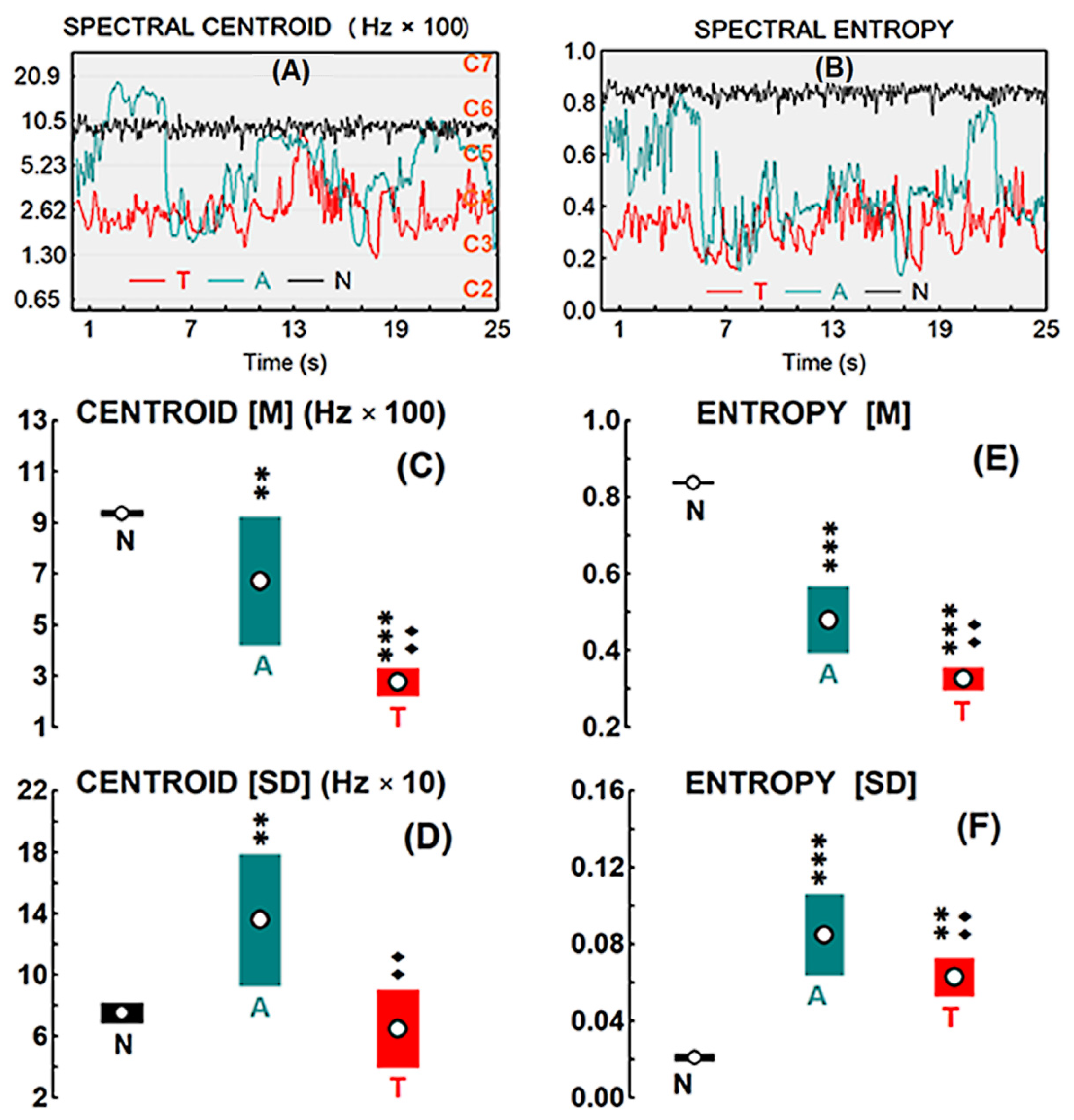

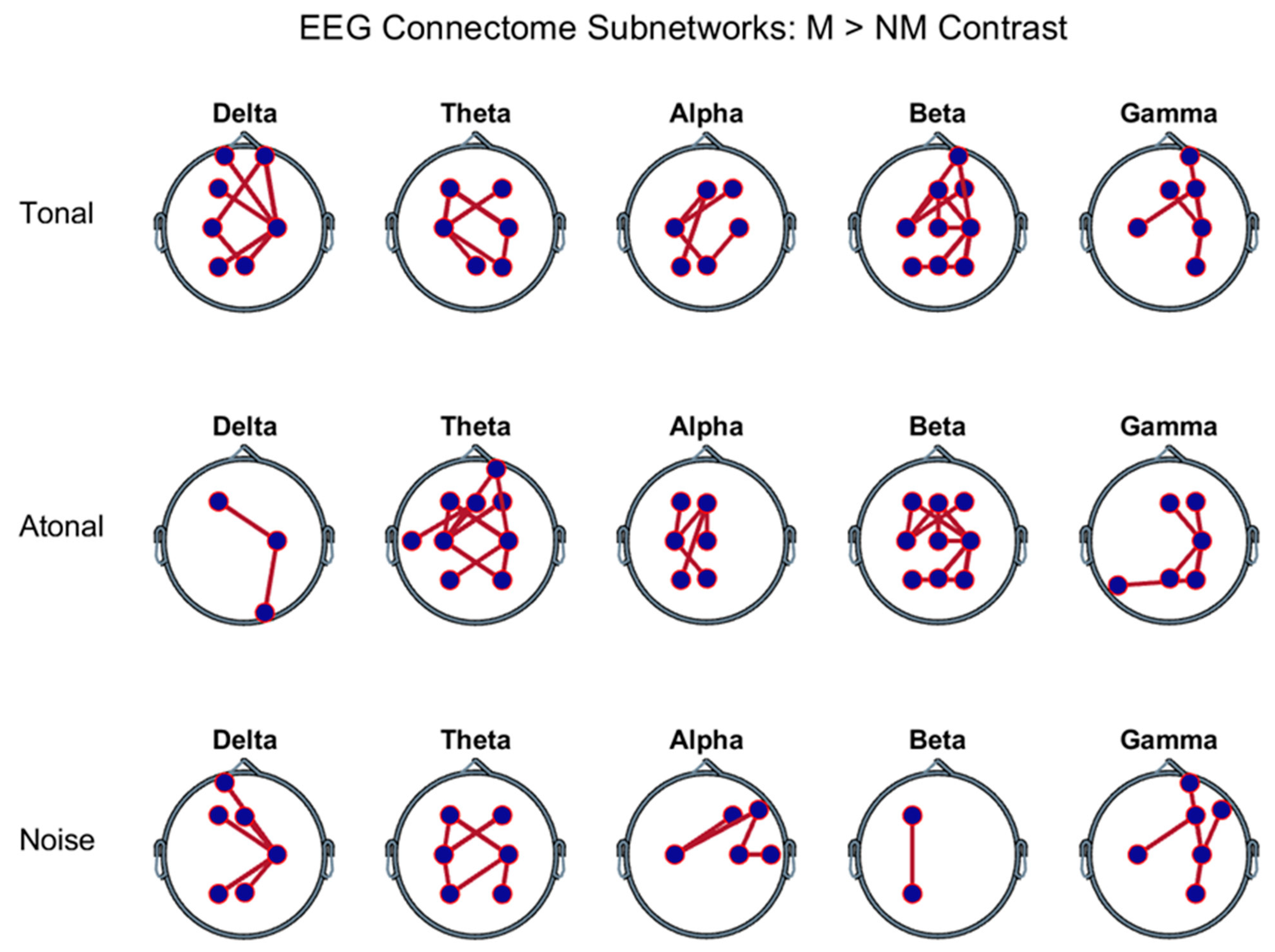

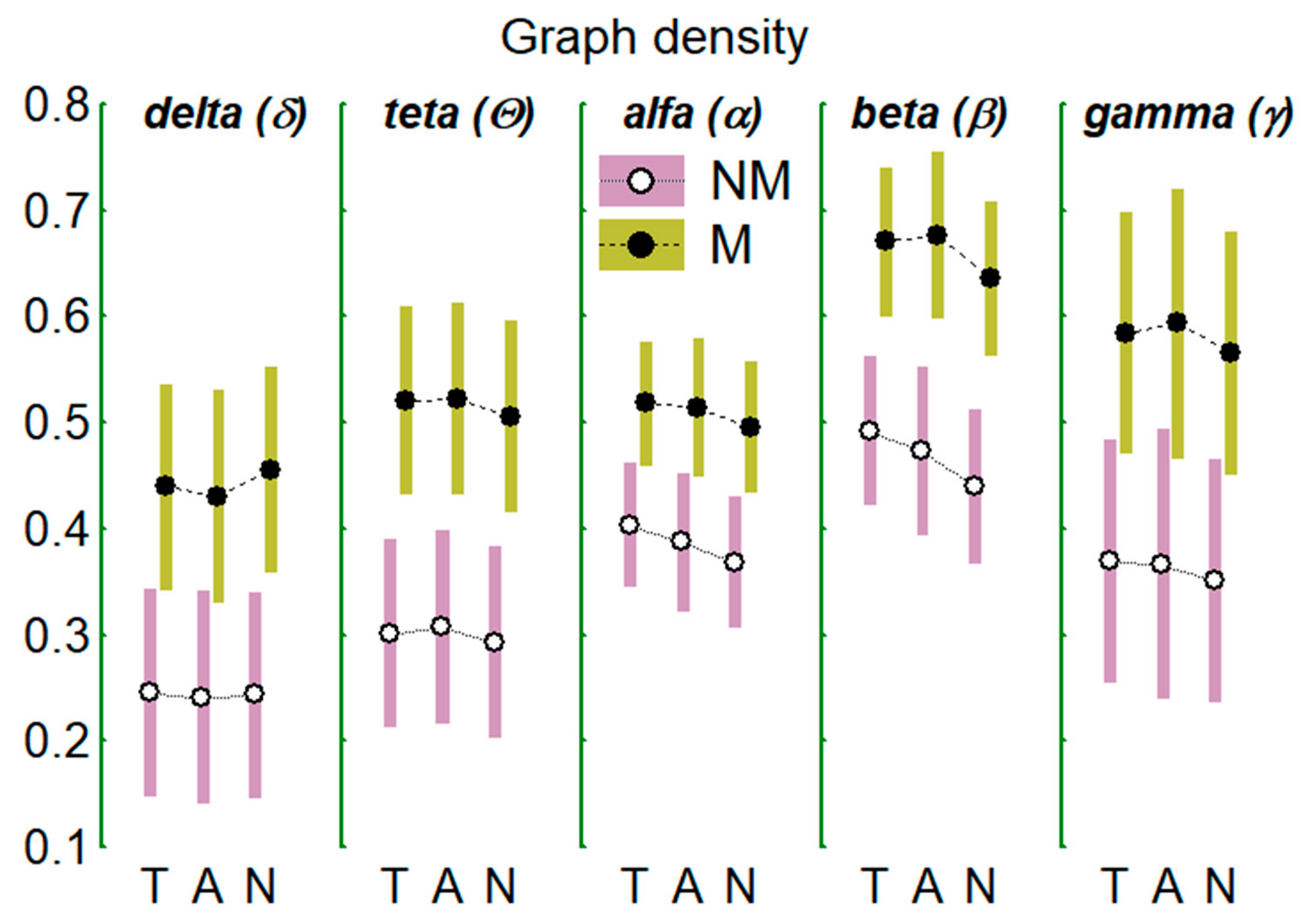
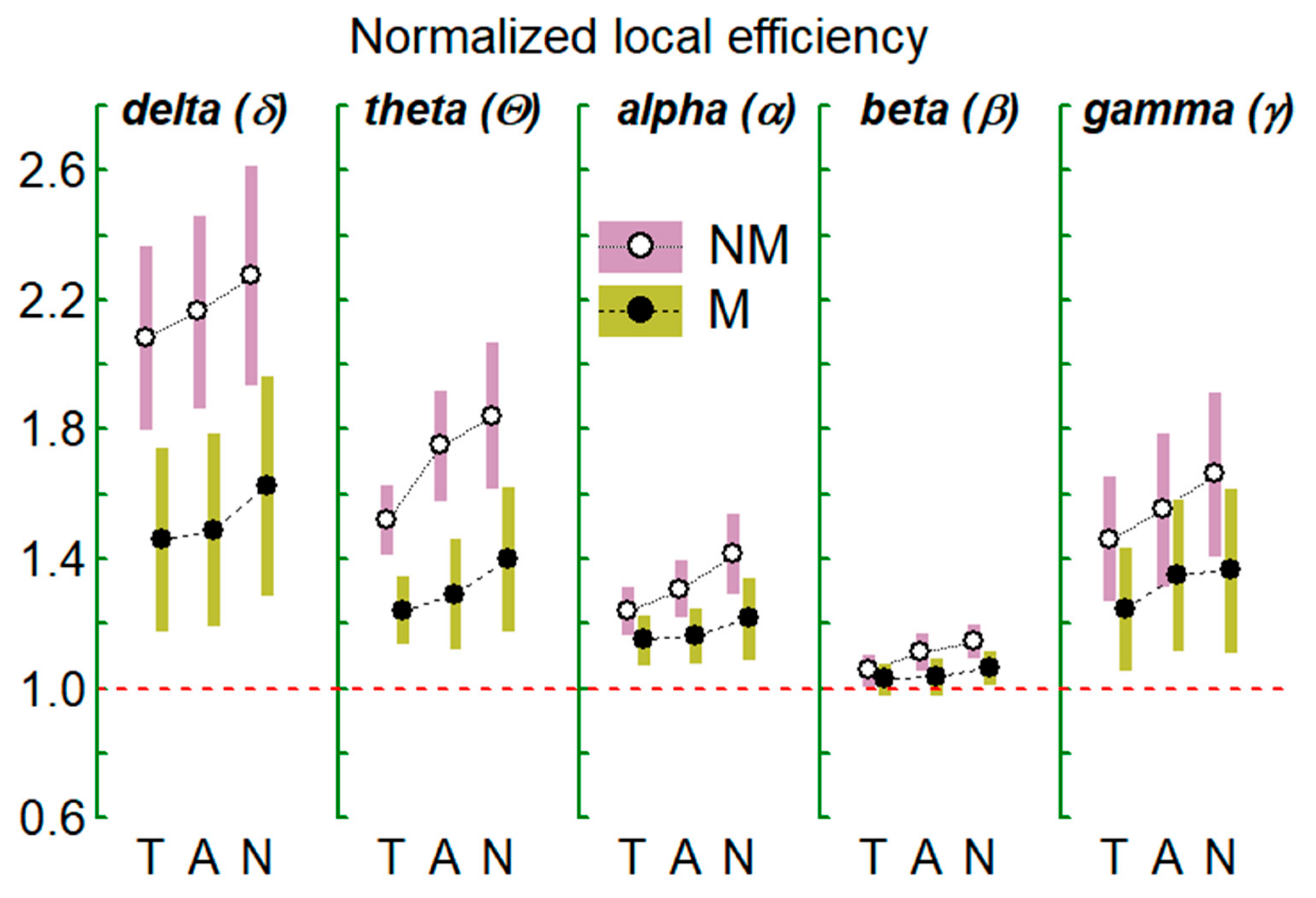

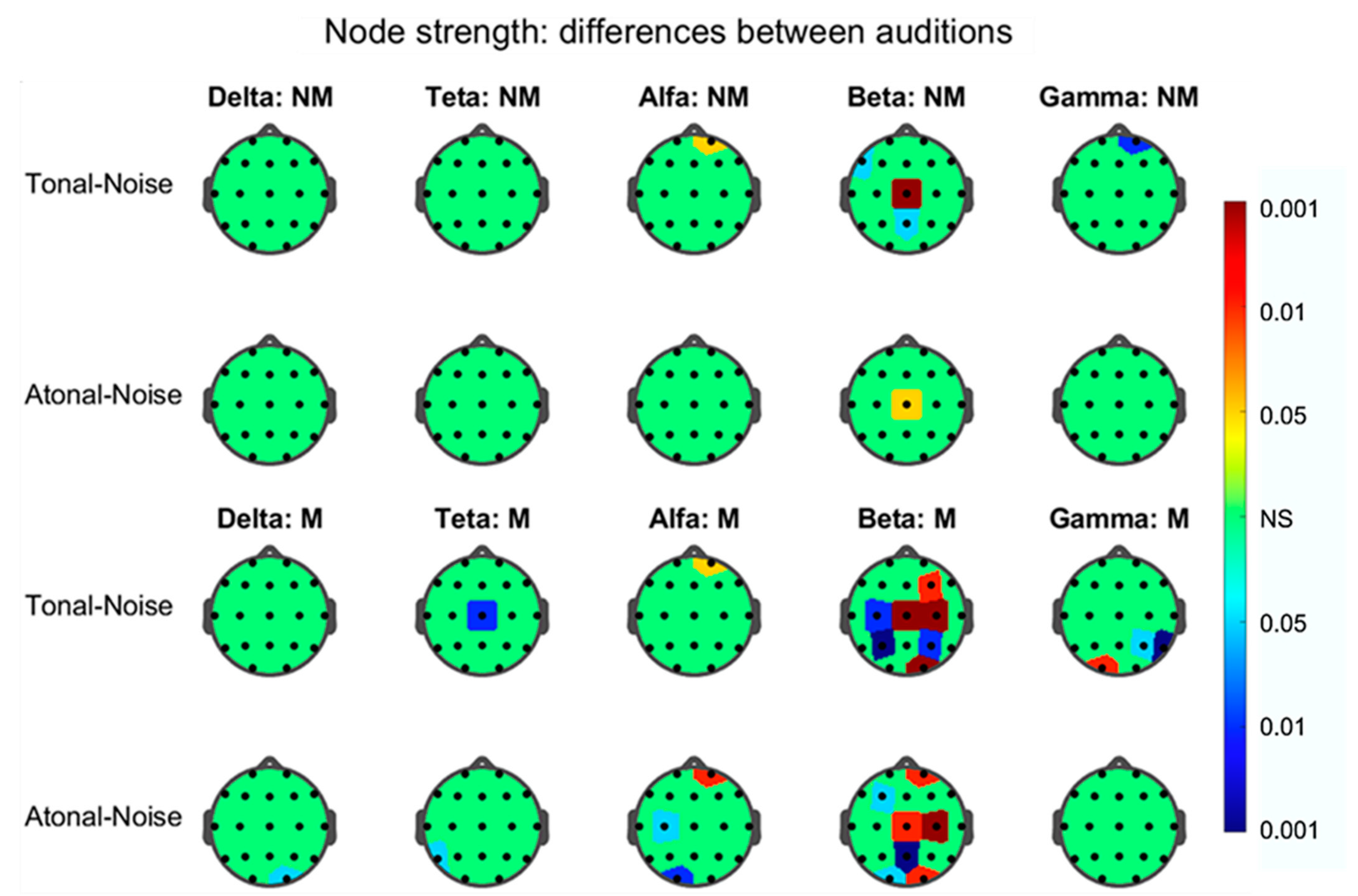
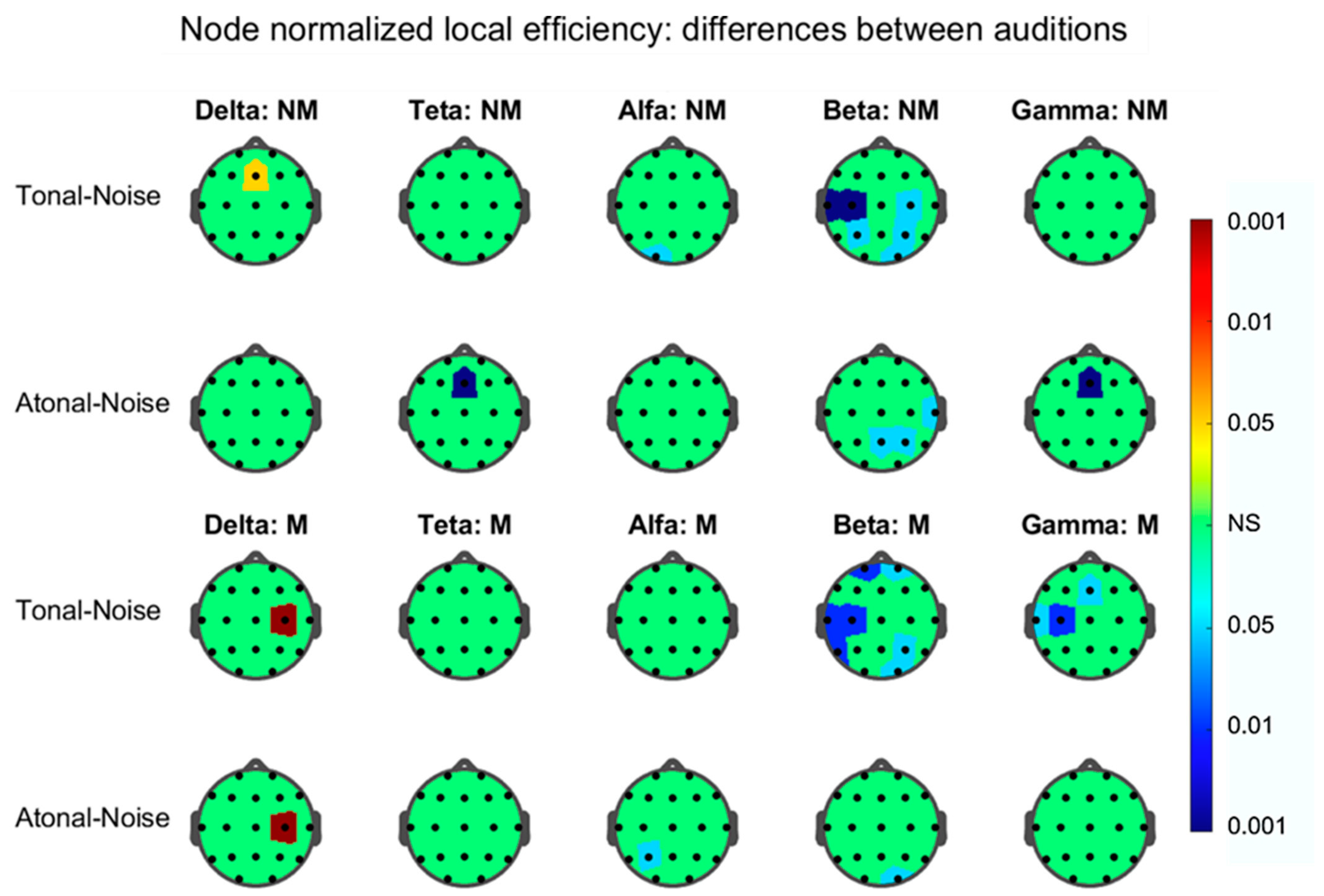

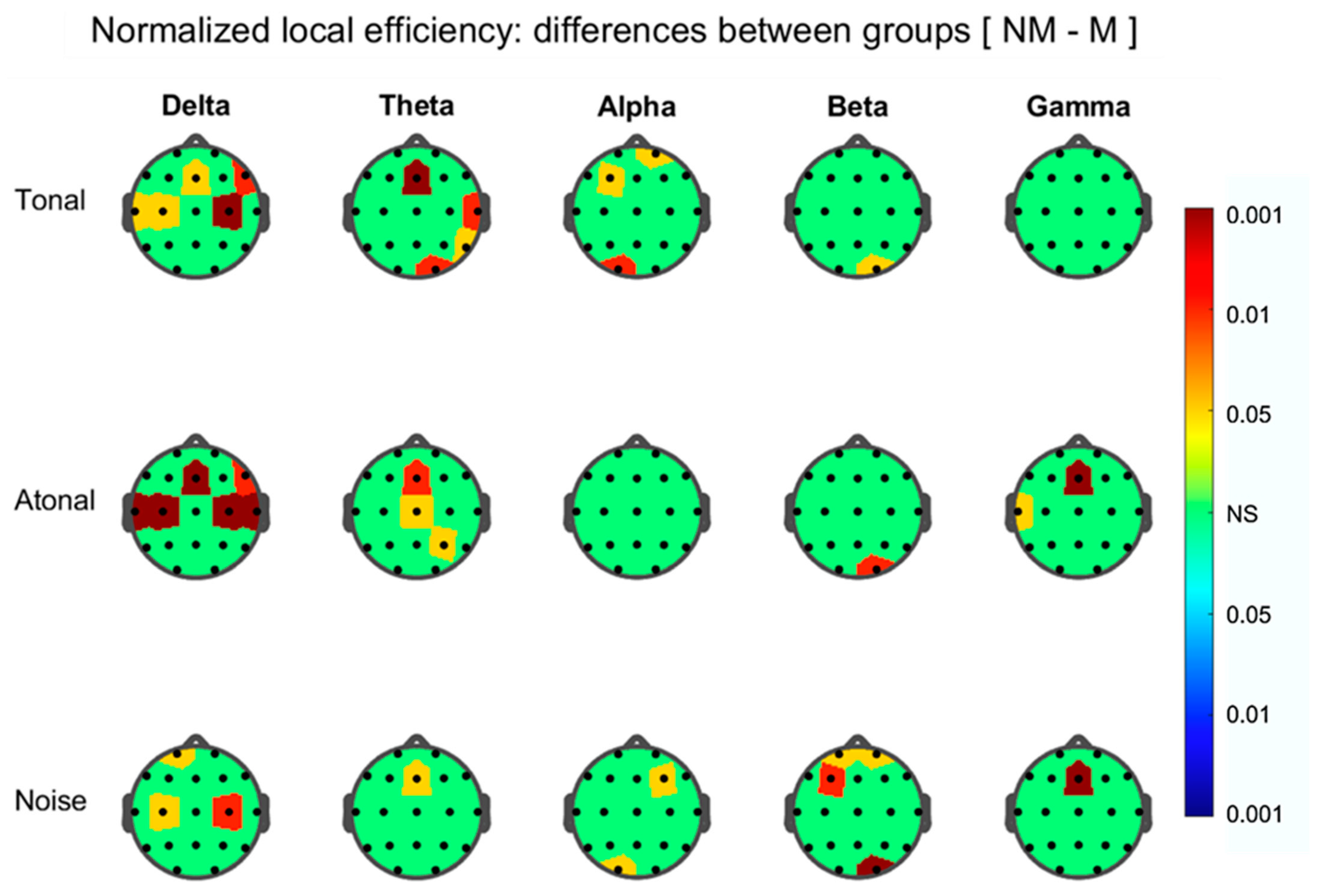
| Factors | Test | F | DF | p | Comp. |
|---|---|---|---|---|---|
| Graph degree | |||||
| MNM | 12.16 | 1.30 | 0.001 | M > NM | |
| FB | L-B | 24.56 | 1.30 | 0.000 | β > δ ***; β > θ ***; β > α ***; β > γ *** |
| Graph density | |||||
| MNM | 12.13 | 1.30 | 0.001 | M > NM | |
| FB | L-B | 26.42 | 1.30 | 0.000 | β > δ ***; β > θ ***; β > α ***; β > γ *** |
| TAN | W-R | 12.59 | 2.29 | 0.000 | B > R ***, C > R ** |
| FB*TAN | L-B | 4.51 | 1.30 | 0.042 | (β): B > R *** |
| Graph strength | |||||
| MNM | 11.67 | 1.30 | 0.001 | M > NM | |
| Factors | Test | F | DF | p | Comp. |
|---|---|---|---|---|---|
| Normalized local efficiency | |||||
| MNM | 13.38 | 1.30 | 0.000 | M < NM | |
| FB | L-B | 31.03 | 1.30 | 0.000 | β < δ ***; β < θ ***; β < γ *** |
| TAN | L-B | 22.79 | 1.30 | 0.000 | T < A **; T < N ***; A < N ** |
| Normalized global efficiency | |||||
| MNM | 4.82 | 1.30 | 0.036 | M > NM | |
| FB | L-B | 31.45 | 1.30 | 0.000 | β > δ ***; β > θ *; β > γ * |
| TAN | W-R | 41.94 | 2.29 | 0.000 | T < A ***; T < N ***; A < N *** |
| FB*TAN | L-B | 4.87 | 1.30 | 0.035 | (δ) T < A ***; T < N ***; (β) T < N *; (γ) T < N * |
Publisher’s Note: MDPI stays neutral with regard to jurisdictional claims in published maps and institutional affiliations. |
© 2021 by the authors. Licensee MDPI, Basel, Switzerland. This article is an open access article distributed under the terms and conditions of the Creative Commons Attribution (CC BY) license (http://creativecommons.org/licenses/by/4.0/).
Share and Cite
González, A.; Santapau, M.; Gamundí, A.; Pereda, E.; González, J.J. Modifications in the Topological Structure of EEG Functional Connectivity Networks during Listening Tonal and Atonal Concert Music in Musicians and Non-Musicians. Brain Sci. 2021, 11, 159. https://doi.org/10.3390/brainsci11020159
González A, Santapau M, Gamundí A, Pereda E, González JJ. Modifications in the Topological Structure of EEG Functional Connectivity Networks during Listening Tonal and Atonal Concert Music in Musicians and Non-Musicians. Brain Sciences. 2021; 11(2):159. https://doi.org/10.3390/brainsci11020159
Chicago/Turabian StyleGonzález, Almudena, Manuel Santapau, Antoni Gamundí, Ernesto Pereda, and Julián J. González. 2021. "Modifications in the Topological Structure of EEG Functional Connectivity Networks during Listening Tonal and Atonal Concert Music in Musicians and Non-Musicians" Brain Sciences 11, no. 2: 159. https://doi.org/10.3390/brainsci11020159
APA StyleGonzález, A., Santapau, M., Gamundí, A., Pereda, E., & González, J. J. (2021). Modifications in the Topological Structure of EEG Functional Connectivity Networks during Listening Tonal and Atonal Concert Music in Musicians and Non-Musicians. Brain Sciences, 11(2), 159. https://doi.org/10.3390/brainsci11020159








